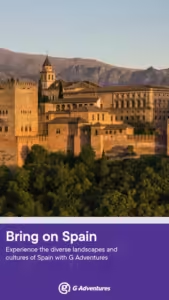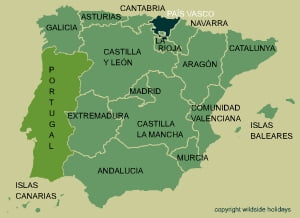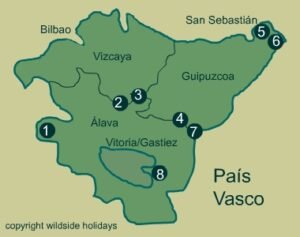Wildlife and walking holidays in País Vasco
- Capital: Gasteiz-Vitoria.
- Area: 7,234 km²
- Provinces 3: Viscaya, Guipuzcoa, Álava
The Basque Country is also known as Euskal Herria in the Basque Language, Pais Vasco in Spanish and Pays Basque in French.
Pais Vasco is separated from the French Basque Country by the Western Pyrenees mountain range.
The Bay of Biscay forms a coastal border in the north. The northern most region in Spain, it contains 19 main rivers.

The five most important rivers flowing into the Bay of Biscay in northern Spain are the Nervión, Bidasoa, Nalón, Sella, and Deva. The Nervión flows through the Basque Country, shaping Bilbao and its surroundings, while the Bidasoa forms a natural border with France, rich in biodiversity. The Nalón is Asturias’ longest river, supporting agriculture and industry, and the Sella is famed for its annual canoe race and beautiful scenery in Asturias. Finally, the Deva flows through Cantabria and Asturias, prized for its clean waters and salmon fishing.
Each river is crucial to the local ecosystem and culture, attracting tourism, supporting wildlife, and enhancing the region’s natural beauty.
The Celts, Romans and Christians had massive influence elsewhere on the Iberian peninsular but here the people have held on to their identity and language, Euskara.
From 1900 to 1970 mining minerals, steel works and ship building created a strong economy. This also brought with it an influx of Spaniards from other regions to take advantage of the boom and in turn has led to a bi-lingual language system.
This industry of the past is now reduced with fishing off the long coastal areas, farming in the mountainous parts and of course tourism dominating the economy of the region.
Find a hotel in the Basque country
[booking_product_helper shortname=”pais vasco”]
Tours in the Basque country from Viator
The basque country has a vast array of sites to visit and enjoy. Below are some of the options listed on the Viator website. (We recieve a small commission if you book a tour which doesn’t cost you more and helps us to keep Wildside Holidays up to date with the best information.)
Natural parks in the basque country
There are a number of Basque breeds and cultivars. These are animals that have been bred – or plant species cultivated – for particular traits and features by Basque people in the Basque Country. Read the fascinating article over at Wikipedia
- 1 The Valderejo Natural Park (Parque natural de Valderejo) is located in the extreme west of the municipality of Valdegovía (The Castilia y Leon area is also protected under the name of Montes Obarenes-San Zadornil Natural Park ). Access is from La Lastra where the Valderejo Natural Park Interpretation Center is located or from the town of Herrán (Burgos).
- 2 The largest protected area in País Vasco, Gorbeia Natural Park is formed around mount Gorbea and the altitude of this area gives it a typical mountain climate: the massif acts as a barrier that stops the humid winds that come from the bay of Biscay, which generates important differences between the north slope, more humid, and the south slope, more dry and sunny. Gorbeia has, consequently, an exceptional wealth of mountain ecosystems with a good state of conservation.
- 3 Urkiola Natural Park is located located in the southeastern corner of Biscay and Álava and within its limits lay the Aramotz, Duranguesado and Arangio mountain ranges. The landscape consists of limestone masses with steep slopes, gullies and cliffs. Karst plains support a diverse and rugged landscape consisting of different proportions of shrubs, grasses, rocks, beech and pine forests.
- 4 At almost 16,000 hectares, the Aizkorri-Aratz Natural Park (Parque natural de Aizkorri-Aratz) is the second-largest protected area in the Basque Country. This is a beautiful mountain area that links (in the form of a mountain corridor) the Pyrenees to the Cantabrian Mountains and here we can find the highest peaks of País Vasco (Aitxuri at 1,551 metres and Aizkorri at 1,544 metres).
- 5 The relatively small protected area of the Pagoeta Natural park is formed by two estates, Pagoeta and Altzola which belong to the Provincial Council of Guipúzcoa. The objective was to create a forestry experimentation area and enhance its natural value, restoring its hardwood stands and protecting its fauna and flora. It is located close to the coast and just 20 km from San Sebastián.
- 6 The Peñas de Aya Natural Park (Aiako Harria in Basque). From Roman times, ore such as silver bearing galena and lead was extracted from the Arditurri mines making them one of the most important ancient mines in Hispania along with Las Médulas mines in Leon and those of Cartagena or Rio Tinto. The mines were abandoned by the Romans in the 5th century, but were exploited again from the Middle Ages until the 1980’s for iron ore making them among the very few in Spain that have been in use for over 2,000 years almost without interruption.
- 7 In the Sierra de Aralar Natural Park between May and November, livestock, especially latxa sheep which provide the milk for Idiazabal cheese, dairy cattle and herds of wild horses graze the area whilst durng the winter months livesock is kept closer to the small villages in the area.
- 8 Located 31 kms from Vitoria-Gasteiz, Izki Natural Park is a vast forest area surrounding the Izki river and flanked by mountains on either side. Standing at 1,176 m, Kapildui is the highest peak and the area is home to Europe’s largest Quercus pyrenaica woodland, covering around 3,500 hectares. There are also wide areas of beech, Portuguese oak, silver birch, English oak and holm oak populations.
The Armañón Natural Park is the ninth and most recently declared protected area in the Basque country. Located in the region of Las Encartaciones in Vizcaya here you will find the Torca del Carlista cave which is one of the the largest underground systems in Europe and a refuge for the main breeding colony of the Mediterranean horseshoe bat.
Looking for guided or self guided walking in Pais Vasco?

Walking North Spain are located in San Sebastian in the heart of a fantastic area for holidays and mountain travel, trips and routes are arranged in most of northern Spain (Basque Country, Navarra, Western Pyrenees, La Rioja, Picos de Europa…), as well as in the French Basque Country and the French Pyrenees. https://wildsideholidays.co.uk/walking-north-spain/
About the author of this article.
I’ve been living in this lovely area of Western Andalucia for the last 20 years or so and dedicate most of my time to the running of English language tourist information websites for the towns of Cádiz, Ronda, Grazalema, the famous or infamous Caminito del Rey, and also Wildside Holidays, which promotes sustainable and eco-friendly businesses running wildlife and walking holidays in Spain.
Ronda Today
Everything you need to know before you visit Ronda “The city of dreams” in Andalucia. https://www.rondatoday.com/
Visit Cádiz
Planning on visiting Cádiz? Tourist information. Monuments. Hotels. Activities. City guides: https://visitingcadiz.com/
The Caminito del Rey
Find tickets for the Caminito del Rey: https://www.caminodelrey.es/
Wildside Holidays – Spain
Take a trip on the Wildside! Discover the wildlife and nature of Spain, its Natural and National Parks and find the top wildlife, activity and walking holiday companies.
Iberia Nature Forum
Struggling with identifying those bugs and beasties? Why not check out the Iberia nature Forum! https://iberianatureforum.com/



